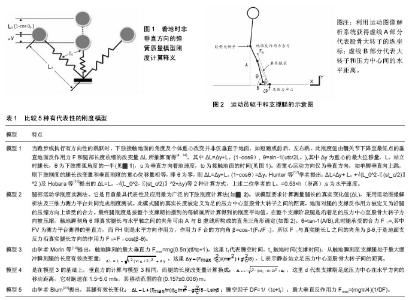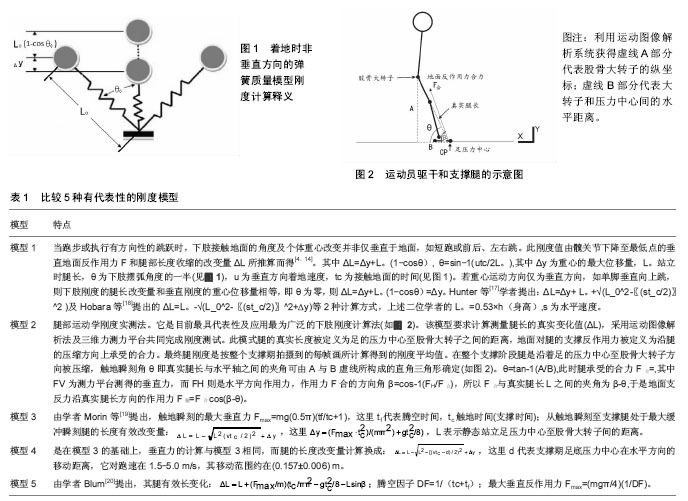Chinese Journal of Tissue Engineering Research ›› 2018, Vol. 22 ›› Issue (8): 1306-1312.doi: 10.3969/j.issn.2095-4344.0153
Stiffness of the lower extremities during landing
Xie Hao-dong1, 2, Luo Jiong1, 2
- 1College of Physical Education, Southwest University, Key Laboratory of Physical Fitness Evaluation and Motor Function Monitor, Chongqing 400715, China; 2Institute for Sports Rehabilitation, Southwest University, Chongqing 400715, China
-
Received:2017-11-09Online:2018-03-18Published:2018-03-18 -
Contact:Luo Jiong, Ph.D., Professor, Master’s supervisor, College of Physical Education, Southwest University, Key Laboratory of Physical Fitness Evaluation and Motor Function Monitor, Chongqing 400715, China; Institute for Sport Rehabilitation, Southwest University, Chongqing 400715, China -
About author:Xie Hao-dong, Master candidate, Teaching assistant, College of Physical Education, Southwest University, Key Laboratory of Physical Fitness Evaluation and Motor Function Monitor, Chongqing 400715, China; Institute for Sport Rehabilitation, Southwest University, Chongqing 400715, China -
Supported by:the Key Program for Olympic Glory of Administration of Sport of Chongqing in 2015, No. A201502
CLC Number:
Cite this article
Xie Hao-dong1, 2, Luo Jiong1, 2. Stiffness of the lower extremities during landing[J]. Chinese Journal of Tissue Engineering Research, 2018, 22(8): 1306-1312.
share this article

2.1 人体刚度模型建立及计算 依据虎克定律,弹性体长度的改变量若属弹性体的弹性限度内,则该弹性体的弹性系数为定值。然而,对人体而言,其弹簧质量模型中的刚度值却不为定值,其自身会伴随动作的特性、施力的现象及环境因素等变量而有所差异。依弹簧质量模型有关人体刚度的定义可分为二类:①转动弹簧质量模型(torsional spring-mass model),即前述的关节刚度;②线性弹簧质量模型(含垂直刚度及下肢刚度)。 2.1.1 转动弹簧质量模型(图1) 关节刚度与旋转有关,因此,从关节刚度可进一步了解各关节刚度与肌肉工作间的相互作用[2]。从查阅到的文献资料看,关节刚度有3计算方法:①最常用的方法为Kjiont =ΔM /Δθ,即净关节肌肉力矩(ΔM)与关节角度变化量(Δθ)之比值[5-8]。也有学者视研究需要,通过获取全部着地期或部分着地期(脚着地至膝关节屈曲最大角度)关节力矩与关节角之间的函数曲线图,此函数曲线图的斜率即关节刚度[9];②利用人体肢段测量及二维运动学参数,并通过跑步机上跑步对耐力跑选手进行膝关节刚度测量,即Kknee=I(Δω2/Δθ2),I表示个体质量乘以大腿长度的平方,Δω为角速度[10];③利用功率-能量方法[11],即在步态着地期,支撑前半段关节所做负功率除以关节角位移变化量:Kjiont =2W-/Δθ,这里W为关节负机械功率。由于该方法对关节角位移变化量的定义不清,故较少有人使用此法。 2.1.2 线性弹簧质量模型(又称垂直刚度) 这种模型刚度值由动作过程中的垂直地面反作用力F和重心的垂直下降位移量Δy所推算而得,其运用在个体质量仅具垂直方向运动的状态,如:跳深[11]、下蹲跳及连续直膝跳(hop)等[4,12-13]。垂直刚度用以描述仅具垂直方向的线性运动特征,如双脚或单脚垂直跳等。综述过去研究文献,其采用的计算方式有3种:①由McMahon与Cheng提 出[14]以垂直方向的最大地面反作用力(Fmax)除以触地后重心的垂直方向的最大位移量(Δy),即Kvert= Fmax/Δy;②McMahon[15]提出利用下肢触地时间及下肢腾空时间以计算自然振动频率(ω0),而人体刚度的计算则是由个体质量(m)乘以ω02,即Kvert=m•ω02;③Granata等[16]提出利用个体质量(m)及时间t(运动频率的时间),即Kvert=m•(2/t)2,此种方法常用于具有频率条件的活动时,例如跑步及连续跳的频率设定。 2.1.3 下肢刚度(又称腿刚度) 下肢刚度是分析腿运动模型的关键数据。许多科学文献对下肢刚度的估测方法都基本采用地面最大反作用力(GRF)与腿压缩ΔL之间的比值,即Kleg=Fmax/ΔL,其中ΔL被看作人体质心的垂直位移、腿长及触地角等运动学参数的函数。由于不同学者该估测函数不一致,目前比较有代表性的刚度模型有5种(表1)。 2.2 人体运动中刚度的作用 2.2.1 不同动作形态下的刚度作用 由于肌肉活化程度、伸展反射、关节力矩及关节角度等因素可改变人体的关节刚度,而关节刚度又将影响下肢关节角度,下肢关节角度的变化影响到下肢长度的改变,从而导致下肢刚度的变异。髋、膝与踝关节刚度的有效调控有利于运动表现[21],如以跑步为例,动作速度与刚度调控有关,研究发现跑速逐渐提升时,下肢刚度与膝关节刚度亦将增加,故跑步者如具有适度的下肢刚度则有利于跑速的提升[22]。Avogadro等[23]研究发现:100 m冲刺跑的前、中与后期各阶段,跑速不同其下肢刚度将随之改变[4,24],当运动员从慢至快增加跑速时,动作速度越快,作用时间则越短,垂直刚度与关节刚度显着提升。在跳跃动作的研究中,Fukashiro等[25]发现,踝关节对于跳跃表现产生垂直推进扮演重要角色,从高台垂直落下,着地后立即反向弹跳,这时膝关节的屈伸作用是控制跳跃表现优劣的关键因素之一,其中着地时关节角度位移量影响着力矩臂距离与地面反作用力参数,致使关节刚度得以适时调控。 着地时间与频率亦是刚度调控的重要因素之一,以20,40与60 cm不同高度跳深着地时发现[26]:随着着地时间减少垂直刚度与踝关节刚度增加,说明随着高度逐渐增加,将产生高水平的肌肉预收缩,使下肢肌肉累积相当张力,在着地时的重心垂直下降位移量较小导致腿部刚度较高,因此,着地接触时间的长短与刚度调控有关。Hobara等[18]进一步比较耐力型与爆发力型运动员在不同频率连续直膝跳时发现:下肢刚度随着频率不同有增加趋势,表现为爆发力型运动员垂直刚度高于耐力型"

| [1] Günther M,Blickhan R.Joint stiffness of the ankle and the knee in running.J Biomech. 2002;35(11):1459-1474. [2] Palmer TB, Jenkins NDM, Thompson BJ,et al.Influence of stretching velocity on musculotendinous stiffness of the hamstrings during passive straight-leg raise assessments. Musculoskelet Sci Pract. 2017;30:80-85.[3] Sano Y, Makimoto A, Hashizume S, et al. Leg stiffness during sprinting in transfemoral amputees with running-specific prosthesis. Gait Posture. 2017;56:65-67.[4] Farley CT, Morgenrotli DC. Leg stiffness primarily depends on ankle stiffness during human hopping. J Biomech.1999;52(3): 267-273.[5] 罗炯.斜坡超速跑训练对短跑运动技术影响的生物力学分析[J].北京体育大学学报,2010,33(6):124-128.[6] Flanagan EP,Harrison AJ. Muscle dynamics differences between legs in healthy adults. J Strength Cond Res.2007; 21(1), 67-72.[7] Hobara H, Inoue K, Muraoka T,et al.Leg stiffness adjustment for a range of hopping frequencies in humans. J Biomech. 2010; 43(3): 506-511.[8] Hobara H, Muraoka T, Omuro K, et al, Knee stiffness is a major determinant of leg stiffness during maximal hopping.J Biomech.2009;42(11):1768-1771.[9] Stefanyshyn DJ,NiggB M. Dynamic angular stiffness of the anklejoint during running and sprinting. J Appl Biomech. 1998;4(4):292-229.[10] Dutto DJ, Braun WA. DOMS-associated changes in ankle and knee-joint- dynamics during running. Med Sci Sports Exerc. 2004;36(4):560-566.[11] De Groote F, Allen JL, Ting LH.Contribution of muscle short-range stiffness to initial changes in joint kinetics and kinematics during perturbations to standing balance: A simulation study.J Biomech. 2017;55:71-77.[12] Hobara H, Kimura K, Omuro K,et al. Determinants of difference in leg stiffness between endurance- and power-trained athletes. J Biomech.2008;47(3): 506-514.[13] Chang AH, Chmiel JS, Almagor O, et al.Association of baseline knee sagittal dynamic joint stiffness during gait and 2-year patellofemoral cartilage damage worsening in knee osteoarthritis.Osteoarthritis Cartilage.2017;25(2):242-248.[14] McMahon TA, Cheng GC. The mechanics of running: How doesstiffness couple with speed?.J Biomech.1990; 25(1): 65-78.[15] McMahon TA, Valiant G,Frederick EC. Groucho running.J Appl Physiol.1987;62(6): 2326-2337.[16] Granata KP, Padua DA,Wilson SE. Gender differences in active-musculoskeletal stiffness. Part II. Quantification of leg stiffness during functional hopping tasks.J Electromyogr Kinesiol. 2002;72(2):127-135.[17] Hunter I,Smith GA.Preferred and optimal stride frequency, stiffness and economy: Changes with fatigue during a 1-h high-intensity run. Eur J Appl Physiol.2007;100(6): 653-661.[18] Hobara H,Kimura K,Omuro K,et al.Differences in lower extremity stiffness between endurance-trained athletes and untrained subjects. J Sci Med Sport.2010;13(1):106-111.[19] Morin JB,Dalleau G,Kyrol ainen H,et al.As implemethod for measuring stiffness during running. J Appl Biomech. 2005;21: 167-180.[20] Blum Y,Lipfert SW,Seyfarth A.Effective leg stiffness in running. J Biomech.2009;42: 2400-2405.[21] Balasundaram AP, Rajan SS. Short-term effects of mobilisation with movement in patients with post-traumatic stiffness of the knee joint . J Bodywork Mov Therap. 2017; 33:1-4.[22] Clark RA.The effect of training status on inter-limb joint stiffness regulation during repeated maximal sprints.J Med Sci Sports.2009;12(3): 406-410.[23] Avogadro P,Kyröläinen H,Belli A.Influence of mechanical and metabolic strain on the oxygen consumption slow component during forward pulled running. Eur J Appl Physiol.2004; 93(1-2): 203-209.[24] Cavagna GA,Heglund NC,Willems PA.Effect of an increase in gravity on the power output and the rebound of the body in human running.J Exp Biol.2005;208(1-2):2333-2346.[25] Fukashiro S, Komi PV.Joint moment and mechanical power flow of the lower limb during vertical jump. Int J Sports Med. 1987;1:15-21.[26] Arampatzis A, Schade F, Walsh M,et al. Influence of leg stiffness and its effect on myodynamic jumping performance. J Electromyogr Kinesiol.2001;11(5): 355-364.[27] Kuitunen S, Komi PV, Kyrolainen H. Knee and ankle joint stiffness insprint running. Med SciSports Exerc.2002;34(22): 166-173.[28] Farley CT,GonzalezO.Leg stiffness and stride frequency in human running.J Biomech. 1996;29(2):181-186.[29] Arampatzis A,Schade F,Walsh M,et al. Influence of legstiffness and its effect on myodynamic jumping performance. J Electromyogr Kinesiol.2001; 77(5):355-364.[30] Moritz CT,Farley CT.Human hopping on very soft elastic surface: Implication for muscle pre-stretch and elastic energy storage in locomotion.J Exp Biol.2005;208(5):939-949.[31] Hobara H, Kanosue K, Suzuki S.Changes in muscle activity with increase in leg stiffness during hopping. Neuroscience Letters.2007;418(1):55-59.[32] Fong Yan A,Smith RM, Hiller CE, et al.Impact attenuation properties of jazz shoes alter lower limb joint stiffness during jump landings. J Sci Med Sport. 2017;20(5):464-468.[33] Self BP,Paine D.Ankle biomechanics during four landing techniques. Med Sci Sports Exerc.2001;33(8): 1338-1344.[34] Stirling AM, McBride JM, Merritt EK,et al.Nervous system excitability and joint stiffness following short-term dynamic ankle immobilization. Gait Posture.2017;59:46-52.[35] Carretero-Navarro G, Márquez G. Effect of different loading conditions on leg stiffness during hopping at different frequencies. Sci Sports.2016;31: e27-e31.[36] Silder A,Besier T,Delp SL.Running with a load increases leg stiffness.J Biomech. J Biomech. 2015;48(6):1003-1008.[37] Cynthia D. Samaan, Michael J. Rainbow, Irene S. Davis.Reduction in ground reaction force variables with instructed barefoot running. J Sport Health Sci.2014;3: 143-151.[38] Powell DW, Williams DS 3rd, Windsor B,et al. Ankle work and dynamic joint stiffness in high- compared to low-arched athletes during a barefoot running task. Hum Mov Sci.2014; 34:147-156.[39] Dutto DJ,Smith GA. Changes in spring-mass characteristics duringtreadmill running to exhaustion. Med Sci Sports Exerc. 2002;34(8):1324-1331.[40] Slawinski J, Heubert R, Quievre J, et al. Changes inspring-mass model parameters and energy cost during track running to exhaustion. J Strength Cond Res.2008;22(3): 930-936.[41] Fourchet F, Girard O, Kelly L, Horobeanu C,et al. Changes in leg spring behaviour, plantar loading and foot mobility magnitude induced by an exhaustive treadmill run in adolescent middle-distance runners.J Sci Med Sport.2015;18: 199–203[42] Hortobagyi T,DeVita P.Muscle pre and coactivity during downwardstepping are associated with leg stiffness in aging. J Electromyogr Kinesiol.2000;10:117-126.[43] Williams III DS, Davis IM, Scholz JP, et al. High-arched runners exhibits increased leg stiffness compared to low-arched runners. Gait and Posture. 2004,19(3):263-269. [44] Murata S, Doi T, Sawa R,et al.Association between joint stiffness and health-related quality of life in community-dwelling older adults.Arch Gerontol Geriatr. 2017;73:234-239.[45] Padua DA,Arnold BL,Garcia CR,et al. Genderdifferences in leg stiffness and stiffness recruitment strategy during two-leggedhopping.J Mot Behav.2005;57(2):111-125. |
| [1] | Zhang Tongtong, Wang Zhonghua, Wen Jie, Song Yuxin, Liu Lin. Application of three-dimensional printing model in surgical resection and reconstruction of cervical tumor [J]. Chinese Journal of Tissue Engineering Research, 2021, 25(9): 1335-1339. |
| [2] | Song Liming, Su Hailong. Muscle force response characteristics of the slipping leg after an unexpected slip [J]. Chinese Journal of Tissue Engineering Research, 2021, 25(8): 1184-1189. |
| [3] | Zeng Yanhua, Hao Yanlei. In vitro culture and purification of Schwann cells: a systematic review [J]. Chinese Journal of Tissue Engineering Research, 2021, 25(7): 1135-1141. |
| [4] | Xu Dongzi, Zhang Ting, Ouyang Zhaolian. The global competitive situation of cardiac tissue engineering based on patent analysis [J]. Chinese Journal of Tissue Engineering Research, 2021, 25(5): 807-812. |
| [5] | Wu Zijian, Hu Zhaoduan, Xie Youqiong, Wang Feng, Li Jia, Li Bocun, Cai Guowei, Peng Rui. Three-dimensional printing technology and bone tissue engineering research: literature metrology and visual analysis of research hotspots [J]. Chinese Journal of Tissue Engineering Research, 2021, 25(4): 564-569. |
| [6] | Chang Wenliao, Zhao Jie, Sun Xiaoliang, Wang Kun, Wu Guofeng, Zhou Jian, Li Shuxiang, Sun Han. Material selection, theoretical design and biomimetic function of artificial periosteum [J]. Chinese Journal of Tissue Engineering Research, 2021, 25(4): 600-606. |
| [7] | Liu Fei, Cui Yutao, Liu He. Advantages and problems of local antibiotic delivery system in the treatment of osteomyelitis [J]. Chinese Journal of Tissue Engineering Research, 2021, 25(4): 614-620. |
| [8] | Li Xiaozhuang, Duan Hao, Wang Weizhou, Tang Zhihong, Wang Yanghao, He Fei. Application of bone tissue engineering materials in the treatment of bone defect diseases in vivo [J]. Chinese Journal of Tissue Engineering Research, 2021, 25(4): 626-631. |
| [9] | Zhang Zhenkun, Li Zhe, Li Ya, Wang Yingying, Wang Yaping, Zhou Xinkui, Ma Shanshan, Guan Fangxia. Application of alginate based hydrogels/dressings in wound healing: sustained, dynamic and sequential release [J]. Chinese Journal of Tissue Engineering Research, 2021, 25(4): 638-643. |
| [10] | Chen Jiana, Qiu Yanling, Nie Minhai, Liu Xuqian. Tissue engineering scaffolds in repairing oral and maxillofacial soft tissue defects [J]. Chinese Journal of Tissue Engineering Research, 2021, 25(4): 644-650. |
| [11] | Xing Hao, Zhang Yonghong, Wang Dong. Advantages and disadvantages of repairing large-segment bone defect [J]. Chinese Journal of Tissue Engineering Research, 2021, 25(3): 426-430. |
| [12] | Chen Siqi, Xian Debin, Xu Rongsheng, Qin Zhongjie, Zhang Lei, Xia Delin. Effects of bone marrow mesenchymal stem cells and human umbilical vein endothelial cells combined with hydroxyapatite-tricalcium phosphate scaffolds on early angiogenesis in skull defect repair in rats [J]. Chinese Journal of Tissue Engineering Research, 2021, 25(22): 3458-3465. |
| [13] | Wang Hao, Chen Mingxue, Li Junkang, Luo Xujiang, Peng Liqing, Li Huo, Huang Bo, Tian Guangzhao, Liu Shuyun, Sui Xiang, Huang Jingxiang, Guo Quanyi, Lu Xiaobo. Decellularized porcine skin matrix for tissue-engineered meniscus scaffold [J]. Chinese Journal of Tissue Engineering Research, 2021, 25(22): 3473-3478. |
| [14] | Mo Jianling, He Shaoru, Feng Bowen, Jian Minqiao, Zhang Xiaohui, Liu Caisheng, Liang Yijing, Liu Yumei, Chen Liang, Zhou Haiyu, Liu Yanhui. Forming prevascularized cell sheets and the expression of angiogenesis-related factors [J]. Chinese Journal of Tissue Engineering Research, 2021, 25(22): 3479-3486. |
| [15] | Liu Chang, Li Datong, Liu Yuan, Kong Lingbo, Guo Rui, Yang Lixue, Hao Dingjun, He Baorong. Poor efficacy after vertebral augmentation surgery of acute symptomatic thoracolumbar osteoporotic compression fracture: relationship with bone cement, bone mineral density, and adjacent fractures [J]. Chinese Journal of Tissue Engineering Research, 2021, 25(22): 3510-3516. |
| Viewed | ||||||
|
Full text |
|
|||||
|
Abstract |
|
|||||